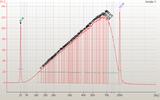I came across this technology for DNA shearing http://www.kbioscience.co.uk/instrum...ept%202008.pdf. Has anyone got any experience with this technology?
Seqanswers Leaderboard Ad
Collapse
Announcement
Collapse
No announcement yet.
X
-
Using the Covaris for shearing DNA has both advantages and disadvantages.
On the plus side you can massively reduce the amount of input DNA, we’ve made shotgun libraries using 500 ng of DNA. On the down side however it’s not as reproducible as using nebulisation.
The attached are screenshots of Agilent traces (without SPRI bead clean up) where the following settings have been used:
Duty cycle = 20%
Intensity = 3
Cycle burst = 200
Time = 45 seconds.
Peak on 1 is at around 640 bp and about 100 bases lover on 2.


Both samples contain 5 ug of DNA in 100 ul of TE. The smaller sized tube was used (max capacity 130 ul) with the fiber in place. It’s also important to use the metal crimped cap as lots of the energy is lost using the plastic ones.
As things stand I wouldn't recommend switching all DNA shearing over to this system but it can be very useful when less starting material is available.
Comment
-
The graphs seem to indicate that there may be a sample viscosity issue and you might want to try some of the following ideas,
-What is the mass of DNA, if it is more than 3ug it is worth trying a "pre-conditioning step"
Simply raise waterbath to 20degC and run a short "blast" 5 secs, (20% duty cycle, level 5 intensity, 200 cycles per burst) prior to the desired fragmentation dose. Up to 20ug/100ul have been run under these conditions.Last edited by Anthony; 02-26-2009, 09:15 AM.
Comment
Latest Articles
Collapse
-
by seqadmin
Proteins are often described as the workhorses of the cell, and identifying their sequences is key to understanding their role in biological processes and disease. Currently, the most common technique used to determine protein sequences is mass spectrometry. While still a valuable tool, mass spectrometry faces several limitations and requires a highly experienced scientist familiar with the equipment to operate it. Additionally, other proteomic methods, like affinity assays, are constrained...-
Channel: Articles
04-04-2024, 04:25 PM -
-
by seqadmin
Despite advancements in sequencing platforms and related sample preparation technologies, certain sample types continue to present significant challenges that can compromise sequencing results. Pedro Echave, Senior Manager of the Global Business Segment at Revvity, explained that the success of a sequencing experiment ultimately depends on the amount and integrity of the nucleic acid template (RNA or DNA) obtained from a sample. “The better the quality of the nucleic acid isolated...-
Channel: Articles
03-22-2024, 06:39 AM -
ad_right_rmr
Collapse
News
Collapse
| Topics | Statistics | Last Post | ||
|---|---|---|---|---|
|
Started by seqadmin, 04-11-2024, 12:08 PM
|
0 responses
24 views
0 likes
|
Last Post
by seqadmin
04-11-2024, 12:08 PM
|
||
|
Started by seqadmin, 04-10-2024, 10:19 PM
|
0 responses
25 views
0 likes
|
Last Post
by seqadmin
04-10-2024, 10:19 PM
|
||
|
Started by seqadmin, 04-10-2024, 09:21 AM
|
0 responses
21 views
0 likes
|
Last Post
by seqadmin
04-10-2024, 09:21 AM
|
||
|
Started by seqadmin, 04-04-2024, 09:00 AM
|
0 responses
52 views
0 likes
|
Last Post
by seqadmin
04-04-2024, 09:00 AM
|
Comment